Dynamic Response and Damage Accumulation of Laminated Composites under Repeated Low-Velocity Impacts
Abstract
1. Introduction
2. Experiment
2.1. Materials
2.2. Repeated Low-Velocity Impact Tests
3. Results and Discussion
3.1. Dynamic Mechanical Response
3.2. Damage Accumulation Assessment
4. Conclusions
- According to the force–time and force–displacement curves, the delamination initiation, fiber breakage and penetration were the three typical characteristics describing the damage evolution of repeated impacts. Compared with the cross-ply laminates, the quasi-isotropic laminates bore higher impact force to produce initial delamination/fiber breakage at the first/second impact and suffered more impacts until penetration.
- The energy absorption of both laminates accumulated with the increasing impact number until penetration, and the impact energy at penetration was completely dissipated. The quasi-isotropic laminates absorbed less energy at each impact, while their total energy absorption was relatively higher, which reflected that this laminated structure possessed higher impact resistance and damage tolerance.
- With the growth of the impact number, the peak force and bending stiffness of both laminates declined continuously, while their maximum central displacement and energy absorption rate increased. The occurrence of fiber breakage intensified these trends to varying degrees. By contrast, the quasi-isotropic laminates showed relatively higher carrying capacity and kept the mechanical properties relatively better when suffering continuous impacts.
- Both the damage indices DI and DI-B showed that the damage accumulation of the quasi-isotropic laminates was relatively slower. By comparison, the index DI-B can characterize damage accumulation from no damage to penetration, corresponding to the value from zero to one, which is more consistent with the common definition of a damage variable.
Author Contributions
Funding
Conflicts of Interest
References
- Boukar, A.; Corn, S.; Slangen, P.; Ienny, P. Finite element modelling of low velocity impact test applied to biaxial glass fiber reinforced laminate composites. Int. J. Impact Eng. 2022, 165, 104218. [Google Scholar] [CrossRef]
- Ge, X.; Zhang, P.; Zhao, F.; Liu, M.; Liu, J.; Cheng, Y. Experimental and numerical investigations on the dynamic response of woven carbon fiber reinforced thick composite laminates under low-velocity impact. Compos. Struct. 2022, 279, 114792. [Google Scholar] [CrossRef]
- Banik, A.; Zhang, C.; Khan, M.; Wilson, M.; Tan, K. Low-velocity ice impact response and damage phenomena on steel and CFRP sandwich composite. Int. J. Impact Eng. 2022, 162, 104134. [Google Scholar] [CrossRef]
- Morais, W.A.; Monteiro, S.; D’Almeida, J. Evaluation of repeated low energy impact damage in carbon-epoxy composite materials. Compos. Struct. 2005, 67, 307–315. [Google Scholar] [CrossRef]
- Sadighi, M.; Alderliesten, R. Impact fatigue, multiple and repeated low-velocity impacts on FRP composites: A review. Compos. Struct. 2022, 297, 115962. [Google Scholar] [CrossRef]
- Katunin, A.; Pawlak, S.; Wronkowicz-Katunin, A.; Tutajewicz, D. Damage progression in fibre reinforced polymer composites subjected to low-velocity repeated impact loading. Compos. Struct. 2020, 252, 112735. [Google Scholar] [CrossRef]
- Zhou, J.; Wen, P.; Wang, S. Numerical investigation on the repeated low-velocity impact behavior of composite laminates. Compos. Part B 2020, 185, 107771. [Google Scholar] [CrossRef]
- Li, L.; Sun, L.; Wang, T.; Kang, N.; Cao, W. Repeated low-velocity impact response and damage mechanism of glass fiber aluminium laminates. Aerosp. Sci. Technol. 2019, 84, 995–1010. [Google Scholar] [CrossRef]
- Guo, K.; Zhu, L.; Li, Y.; Yu, T.; Shenoi, A.; Zhou, Q. Experimental investigation on the dynamic behaviour of aluminum foam sandwich plate under repeated impacts. Compos. Struct. 2018, 200, 298–305. [Google Scholar] [CrossRef]
- Wang, C.; Chen, Z.; Silberschmidt, V.V.; Roy, A. Damage accumulation in braided textiles-reinforced composites under repeated impacts: Experimental and numerical studies. Compos. Struct. 2018, 204, 256–267. [Google Scholar] [CrossRef]
- Sevkat, E.; Liaw, B.; Delale, F.; Raju, B.B. Effect of repeated impacts on the response of plain-woven hybrid composites. Compos. Part B 2010, 41, 403–413. [Google Scholar] [CrossRef]
- Atas, C.; Icten, B.M.; Küçük, M. Thickness effect on repeated impact response of woven fabric composite plates. Compos. Part B 2013, 49, 80–85. [Google Scholar] [CrossRef]
- Zhou, J.; Liu, B.; Wang, S. Finite element analysis on impact response and damage mechanism of composite laminates under single and repeated low-velocity impact. Aerosp. Sci. Technol. 2022, 129, 107810. [Google Scholar] [CrossRef]
- Dogan, A. Single and repeated low-velocity impact response of E-glass fiber-reinforced epoxy and polypropylene composites for different impactor shapes. J. Thermoplast. Compos. Mater. 2019, 35, 320–336. [Google Scholar] [CrossRef]
- Sun, Z.; Li, C.; Tie, Y. Experimental and numerical investigations on damage accumulation and energy dissipation of patch-repaired CFRP laminates under repeated impacts. Mater. Des. 2021, 202, 109540. [Google Scholar] [CrossRef]
- Icten, B.M. Low temperature effect on single and repeated impact behavior of woven glass-epoxy composite plates. J. Compos. Mater. 2015, 49, 1171–1178. [Google Scholar] [CrossRef]
- Liao, B.; Zhou, J.; Li, Y.; Wang, P.; Xi, L.; Gao, R.; Bo, K.; Fang, D. Damage accumulation mechanism of composite laminates subjected to repeated low velocity impacts. Int. J. Mech. Sci. 2020, 182, 105783. [Google Scholar] [CrossRef]
- Belingardi, G.; Cavatorta, M.P.; Paolino, D.S. A new damage index to monitor the range of the penetration process in thick laminates. Compos. Sci. Technol. 2008, 68, 2646–2652. [Google Scholar] [CrossRef]
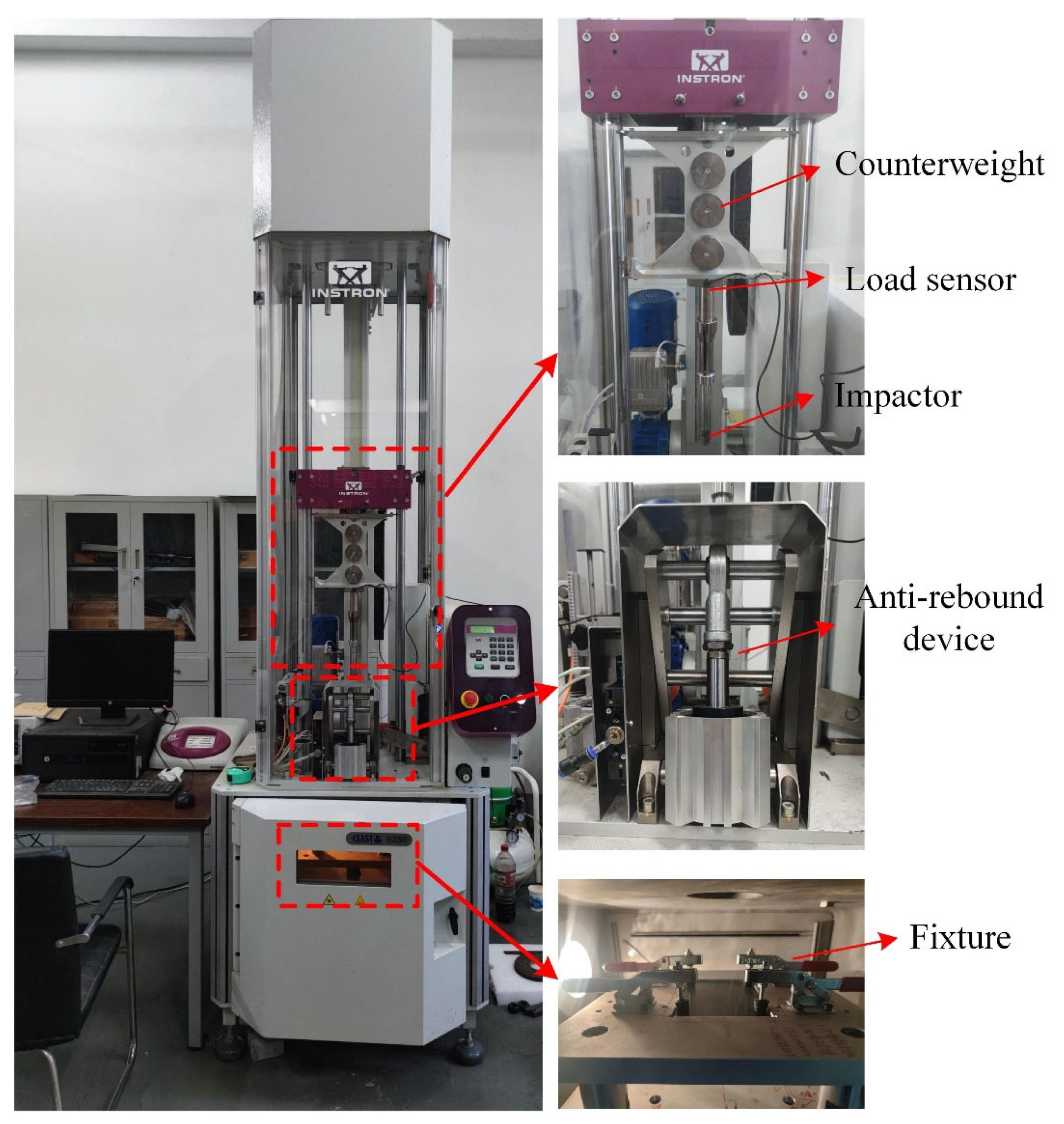
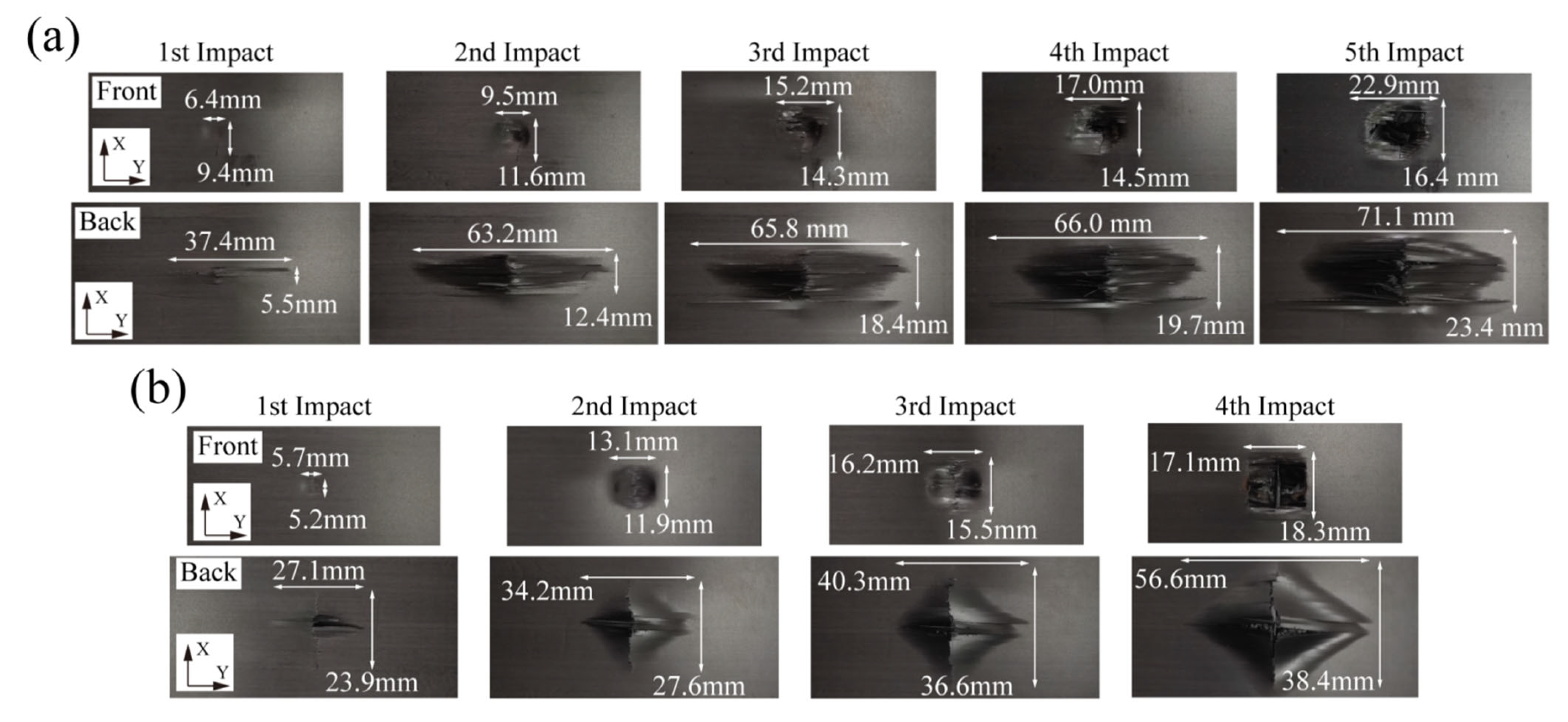
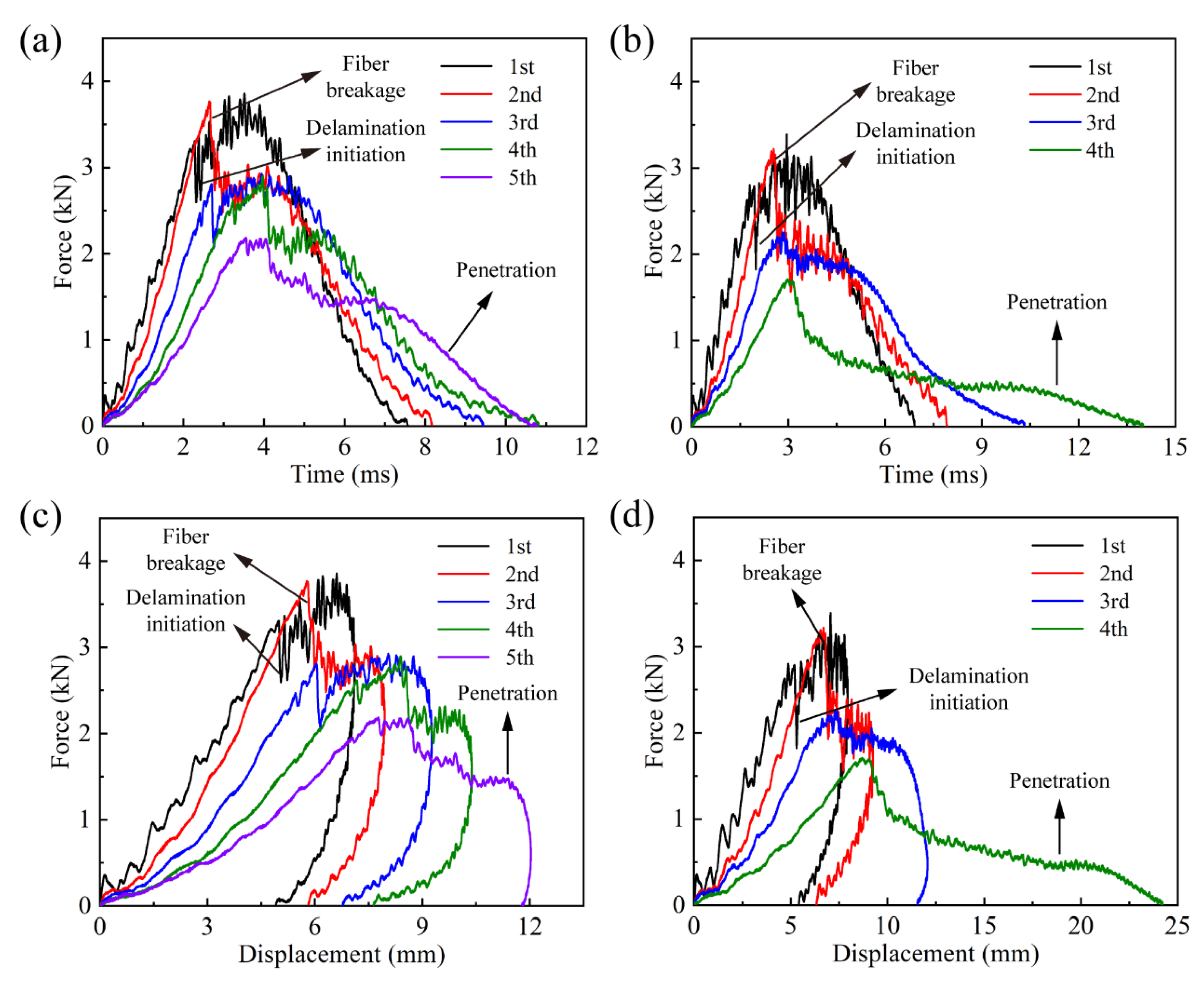
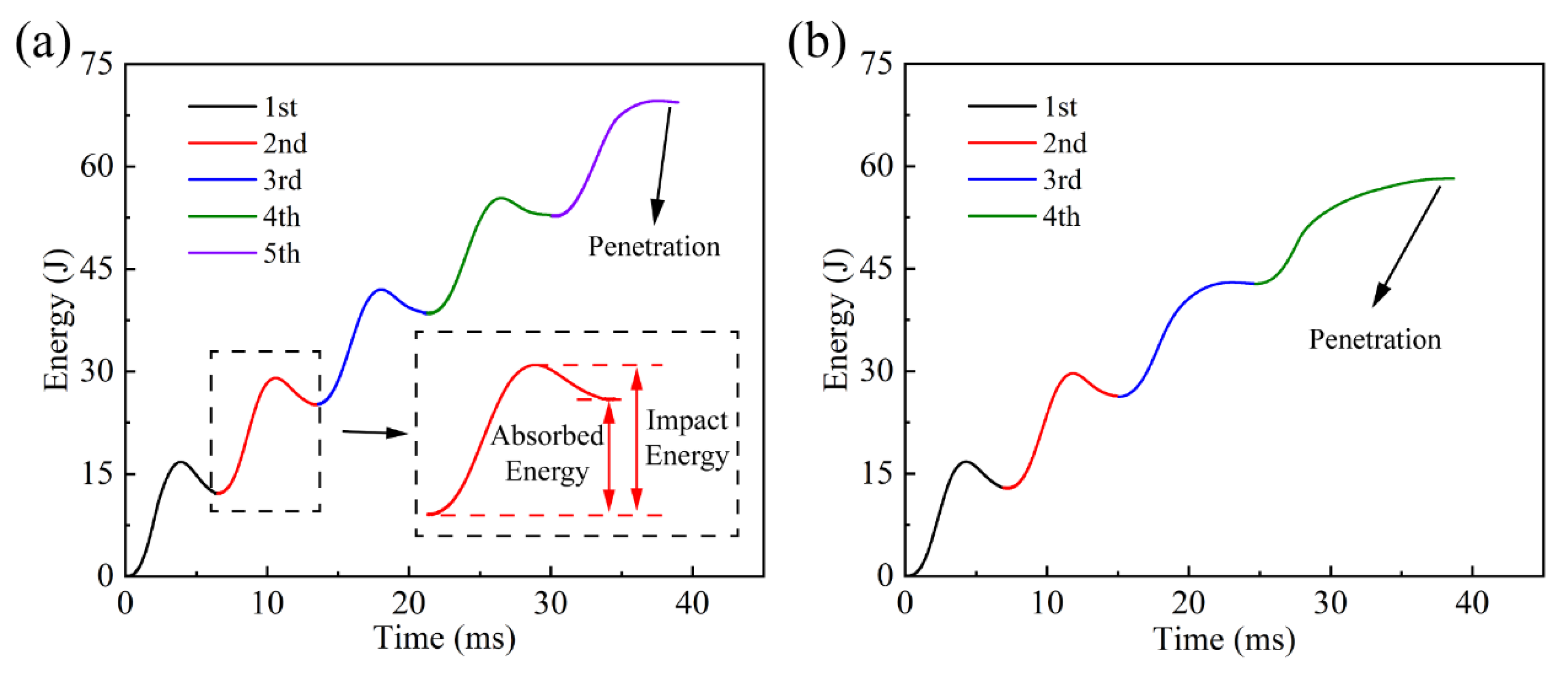

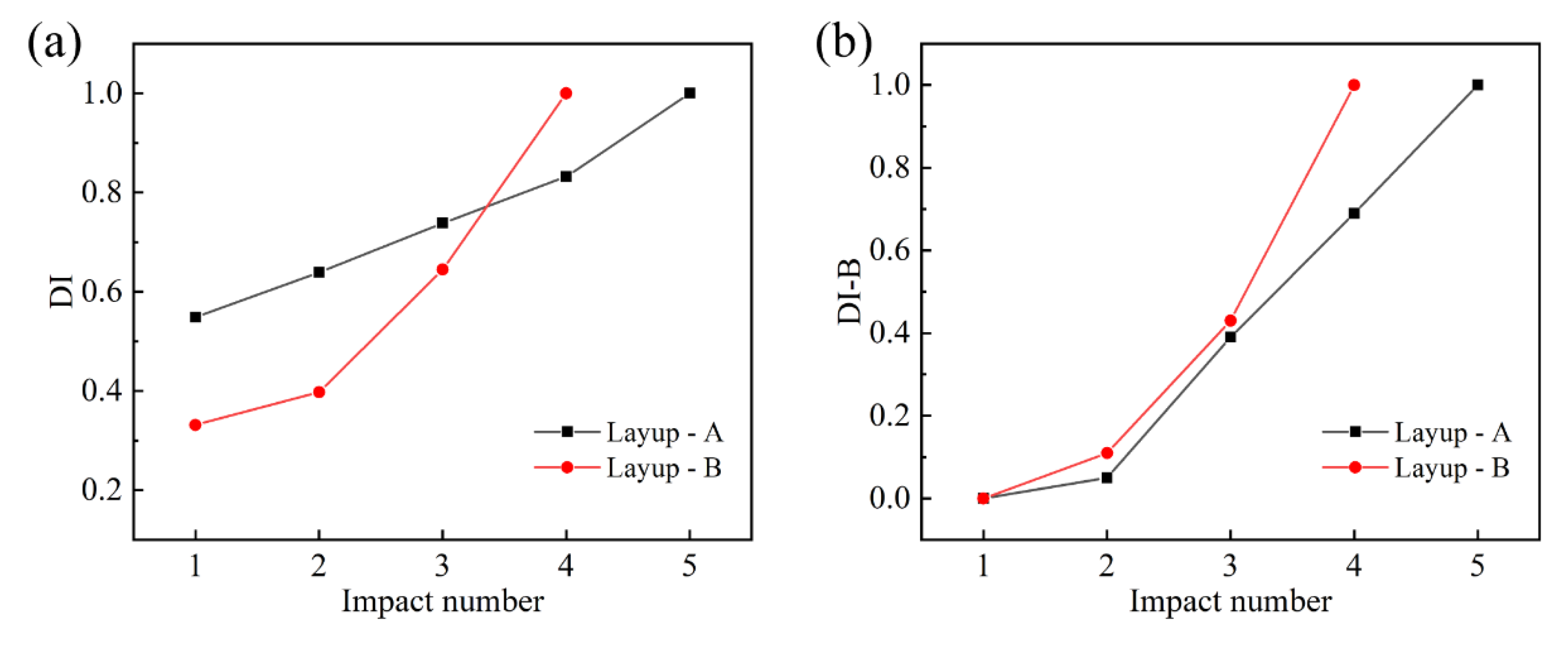
| Mechanical Properties | Values |
|---|---|
| Longitudinal elastic modulus (E11) | 130 GPa |
| Transverse elastic modulus (E22) | 7 GPa |
| Shear modulus (G12) | 3.6 GPa |
| Poisson’s ratio (m12) | 0.3 |
| Longitudinal tensile strength (XT) | 1760 MPa |
| Longitudinal compressive strength (XC) | 1100 MPa |
| Transverse tensile strength (YT) | 51 MPa |
| Transverse compressive strength (YC) | 167 MPa |
| Shear strength (t12) | 70 MPa |
| Density (r) | 1600 kg/m3 |
Disclaimer/Publisher’s Note: The statements, opinions and data contained in all publications are solely those of the individual author(s) and contributor(s) and not of MDPI and/or the editor(s). MDPI and/or the editor(s) disclaim responsibility for any injury to people or property resulting from any ideas, methods, instructions or products referred to in the content. |
© 2023 by the authors. Licensee MDPI, Basel, Switzerland. This article is an open access article distributed under the terms and conditions of the Creative Commons Attribution (CC BY) license (https://creativecommons.org/licenses/by/4.0/).
Share and Cite
Sun, J.; Huang, L.; Dai, Y. Dynamic Response and Damage Accumulation of Laminated Composites under Repeated Low-Velocity Impacts. Materials 2023, 16, 778. https://doi.org/10.3390/ma16020778
Sun J, Huang L, Dai Y. Dynamic Response and Damage Accumulation of Laminated Composites under Repeated Low-Velocity Impacts. Materials. 2023; 16(2):778. https://doi.org/10.3390/ma16020778
Chicago/Turabian StyleSun, Jin, Linhai Huang, and Yunfeng Dai. 2023. "Dynamic Response and Damage Accumulation of Laminated Composites under Repeated Low-Velocity Impacts" Materials 16, no. 2: 778. https://doi.org/10.3390/ma16020778
APA StyleSun, J., Huang, L., & Dai, Y. (2023). Dynamic Response and Damage Accumulation of Laminated Composites under Repeated Low-Velocity Impacts. Materials, 16(2), 778. https://doi.org/10.3390/ma16020778





